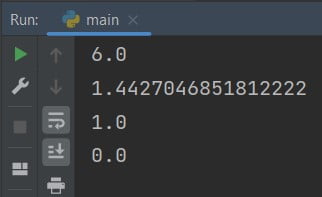Python math log2 function is used to get the logarithm of a given number, raised to a base 2. The log2 function is a built-in function and it returns the base-2 logarithm of a float value.
math.log2(x)In some scenarios the return values of the log2 function:
- If we pass a positive number then the function returns the correct output.
- In case we pass a negative number then the log2 function raises a ValueError exception and returns the same.
- If pass some non-numeric then the log2log2 function returns the TypeError exception.
Python math log2 function example
Simple example code Calculating Logarithm using log2 in Python.
import math
# Positive Number
print(math.log2(64))
print(math.log2(2.7183))
print(math.log2(2))
print(math.log2(1))
# Negative Number
# print(math.log2(-32)) # ValueError
# Non-numeric Value
# print(math.log2('a')) # TypeError
Output:

Do comment if you have any doubts or suggestions on this Python math module topic.
Note: IDE: PyCharm 2021.3.3 (Community Edition)
Windows 10
Python 3.10.1
All Python Examples are in Python 3, so Maybe its different from python 2 or upgraded versions.